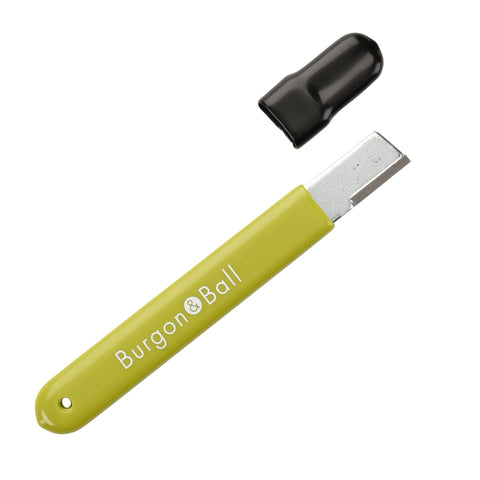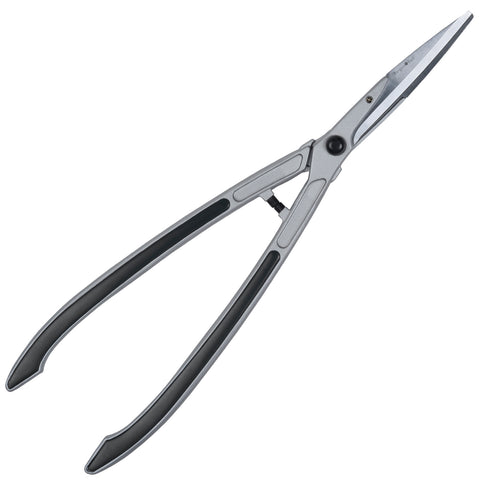THIS GIVEAWAY HAS NOW CLOSED
 At Burgon & Ball we like to support emerging talent in the world of horticulture. After all, the people starting out on their careers are the people who will be giving us gardening inspiration for years to come, so we try to do what we can to help out.
At Burgon & Ball we like to support emerging talent in the world of horticulture. After all, the people starting out on their careers are the people who will be giving us gardening inspiration for years to come, so we try to do what we can to help out.
Last year we supported young garden designer Kristian Reay with some tools, as he created his 'Summer Breeze' entry in the Long Border competition at the RHS Chatsworth Flower Show. You can read more about Kristian’s RHS show debut here. The judges obviously saw his talent and hard work, rewarding his border with a silver medal.
So we were excited to learn that this year Kristian has entered a Young Designer garden at RHS Tatton Park Flower Show. This competition is a real springboard for young designers, providing an excellent showcase for their work. In 2016 we helped out Lilly Gomm with tools to build and accessorise her RHS Tatton Park garden; this year she won her first Chelsea gold medal.

Fragile beauty with a darker message
Kristian's RHS Tatton Park garden this year carries an important message. Entitled 'The Phytosanctuary Garden', it's a beautiful space, awash with ornamental grasses and a palette of fragrant perennials evocative of the Mediterranean – the type of planting which is increasingly likely to thrive in the UK as our climate changes, and summers become hotter.
Lavender, Portuguese laurel and artemisia frame the centrepiece, a graceful multi-stemmed olive tree. In the shade of the olive, soothed by the gentle aroma of warm rosemary, it's an idyllic place to sit on hot afternoons, soaking up the warmth as bees buzz around the fragrant purple lavender blooms...
Yet these plants, the very plants that remind us of happy holidays, can carry a hidden danger. For his garden, Kristian has carefully selected some of the varieties most at risk from plant diseases like Xylella fastidiosa; diseases which, if they take a hold in the UK, could have devastating results.
 Real and present danger
Real and present danger
Xylella is a bacterial pathogen which has severely affected large areas of European horticulture. More than 500 plant species are vulnerable to Xylella, including crops, trees and ornamental plants. In Italy it has killed millions of trees and has devastated ancient olive groves, with massive ecological, economic and social impact. It is transmitted by insect vectors that feed on fluid in the xylem, the plant tissue which transports water from roots to leaves - and without water, or course, the plant slowly dies.
Kristian explains: “As a young designer I’m very concerned about the risk from plant diseases like Xylella to our gardens and landscapes, and I wanted to highlight this important issue at the show. I created the garden around a lone olive tree to symbolise the damage the disease can cause, and included at-risk garden favourites like lavender in the planting to show the impact the disease could have if these plants were to vanish."
He continues: “I feel it’s vital to get gardeners thinking about how they can help to control the risk of disease, which is why I’ve arranged for a display adjacent to the garden, describing the BRIGIT project and the Defra and Animal and Plant Health Agency’s Don’t Risk It! campaign. If you’re visiting the garden, please take time to take in this important information.”
 Preparation and prevention
Preparation and prevention
The main carrier of the bacteria is the spittlebug, or froghopper. In some areas of the UK, the 'cuckoo spit' that the nymphs of these insects produce is not an unfamiliar sight in our gardens, but we need to be vigilant as the risk of disease grows. The range of the spittlebug is expected to grow as summers get hotter, and to help track the spread of the insects, the BRIGIT Project has launched a website where gardeners can report sightings of the telltale froth on plants. If you've spotted it in your garden, please do report it online to help monitor the risk.
Overall, there are other steps which we as gardeners can take to help reduce the risk of disease spread:
Prevention: Everybody loves a holiday souvenir, but if you are planning an exotic break this summer please don’t bring any plants back with you.
Preparation: Help prepare for a potential Xylella outbreak by taking part in the BRIGIT ‘Bug Hunt’ to map the distribution of spittlebugs in the UK
Provenance: Ask your suppliers about the provenance of their plants. By supporting British growers and nurseries with the highest biosecurity standards we can ensure healthy plants for years to come.
Propagation: What better way to help prevent the spread of pests and diseases than growing your own plants? If you have too many, why not swap with a neighbour. Think local!
Pruning: Regularly sharpen pruners and blades. Always clean your tools between uses, especially if you are moving between sites.
Packaging: Remember, It’s not just living plants that present a biosecurity hazard. Untreated wooden packaging can also provide an entry route for new pests and diseases
 Prize draw: win RHS-endorsed cutting tools worth over £200
Prize draw: win RHS-endorsed cutting tools worth over £200
To help with the ‘Pruning’ element of these six steps to controlling Xylella, we're giving away a bumper bundle of our razor-sharp RHS-endorsed cutting tools to make sure you get a cleaner cut when you're pruning your plants. A clean cut avoids crushing the stem, which means less chance of introducing infection to the plant.
The prize pack consists of:
RHS-endorsed wooden-handled pruning knife - a beautiful heirloom quality knife with a hooked blade for efficient cutting
RHS-endorsed flower and fruit snip - sharp scissor-action blades for precision harvesting of fruit and flowers
RHS-endorsed professional bypass secateur - our highest-specification secateur, ideal for everyday cutting
RHS-endorsed rotating handle bypass secateur - gently rotating handle minimises muscle fatigue on cuts up to 2.5cm
RHS-endorsed precision shear - super-lightweight, razor-sharp shear for precision shaping and trimming of shrubs and hedges
RHS-endorsed bypass lopper - the compound action brings superior cutting performance; up to 50% more cutting power
Blade Edge Restorer - super-carbide file and non-slip grip makes this on-the-go sharpener easy to use
 If you're the lucky winner, you're very welcome to swap to a compact version of the pruning knife and professional bypass secateur - just let us know! Together, these RHS-endorsed cutting tools will help you make clean, healthy cuts on live wood and stems, as you prune and propagate your plants.
If you're the lucky winner, you're very welcome to swap to a compact version of the pruning knife and professional bypass secateur - just let us know! Together, these RHS-endorsed cutting tools will help you make clean, healthy cuts on live wood and stems, as you prune and propagate your plants.
With thanks to Kristian Reay for throwing the spotlight on the growing dangers presented by Xylella, with his beautiful and thought-provoking show garden at RHS Tatton Park. Congratulations on a well-deserved gold medal, and on winning the prestigious Best RHS Young Designer award!
See more of Kristian’s garden on Instagram or on the RHS website, or visit his website at www.kristianreay.uk.
How to enter
THIS GIVEAWAY HAS NOW CLOSED
To win this pack of RHS-endorsed cutting tools, all you need to do is leave a comment on this blog. Scroll to the bottom of this page to comment (your email address won't be published).
 Here's the small print:
Here's the small print:
The Phytosanctuary Garden prize draw, 2019
This giveaway is open to UK residents over the age of 18 only. No purchase necessary. No cash alternative is available. Winners will be chosen at random and the judges’ decision will be final. 1 winner will receive one (1) RHS-endorsed wooden-handled pruning knife; one (1) RHS-endorsed flower and fruit snip; one (1) RHS-endorsed professional bypass secateur; one (1) RHS-endorsed rotating handle bypass secateur; one (1) RHS-endorsed precision shear; one (1) RHS-endorsed bypass lopper; one (1) Burgon & Ball Blade Edge Restorer. Prize draw opens at 00:01 on 16/07/2019 and closes at 23:59 on 31/07/2019. Winners will be contacted by Burgon & Ball shortly after the closing date. Employees of Burgon & Ball and employees of Kristian Reay and their family members aren’t eligible to win. One entry per person; entries created by a bot or a service that automatically enters participants are not eligible to win. We draw your attention to our privacy policy here.








The Phytosanctuary garden delivers a strong an important message for bio-security and being aware of the source of plants.
The Phytosanctuary garden is exactly what I strive for in my garden. I love the natural look which could let you believe it had just ‘happened’ although I suspect an enormous amount of work went into it. To add to that it’s highlighted a serious problem which we should all take on board. So much more than a garden!
Always more to learn about plants and gardens and everything involved in creating and caring for them. I’m a proud Sheffieler with a garden that grows way too fast, but I wouldn’t be without my outdoor space. Very lucky to have it and all the work it entails.
Loved the garden at Tatton and I’m a big fan of burgon and ball tools. I’d love to upgrade what I have to this whole collection!
We all need to do our bit to try to prevent the spread of this worrying disease.